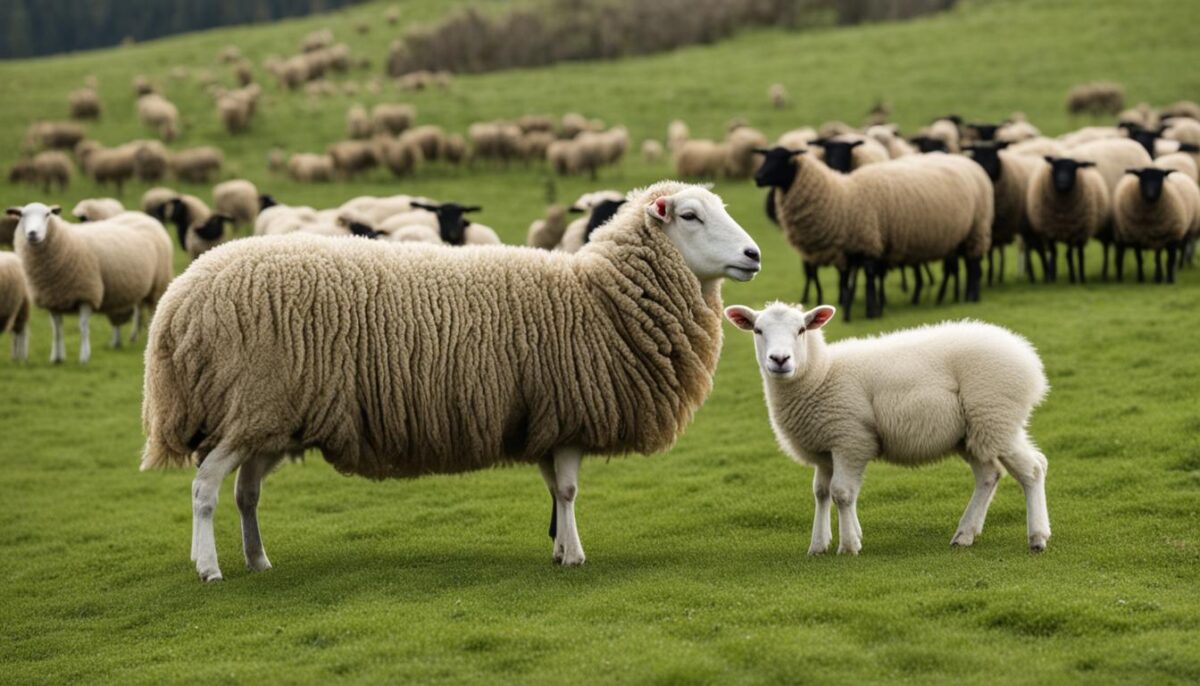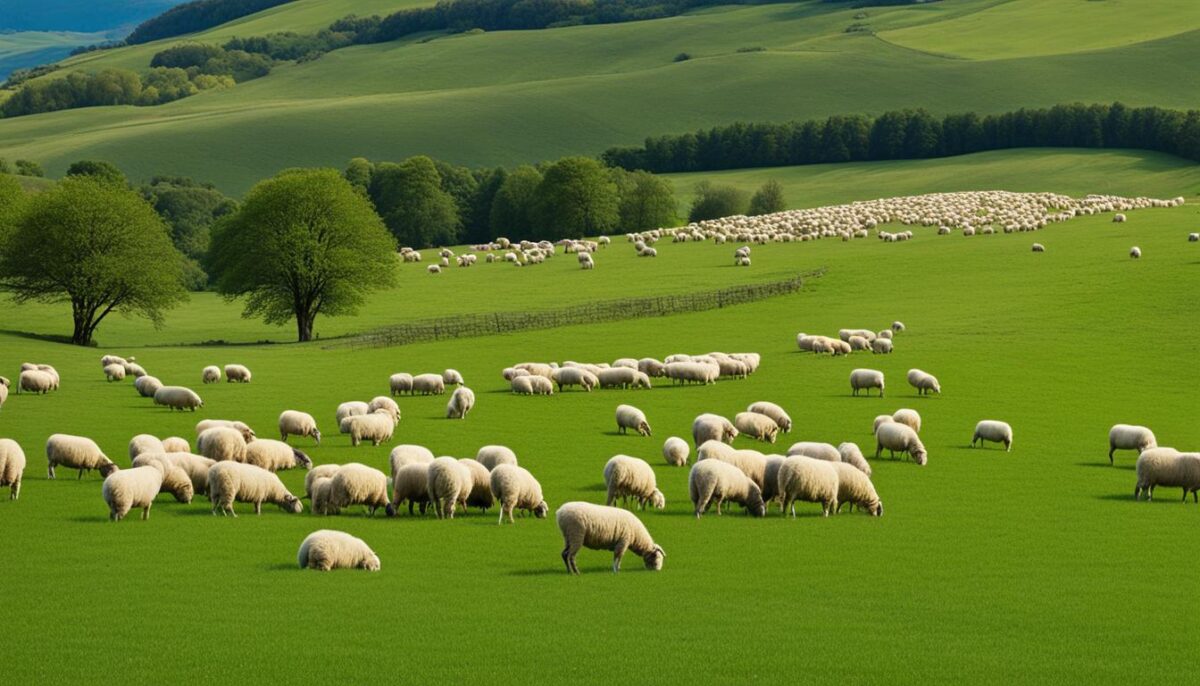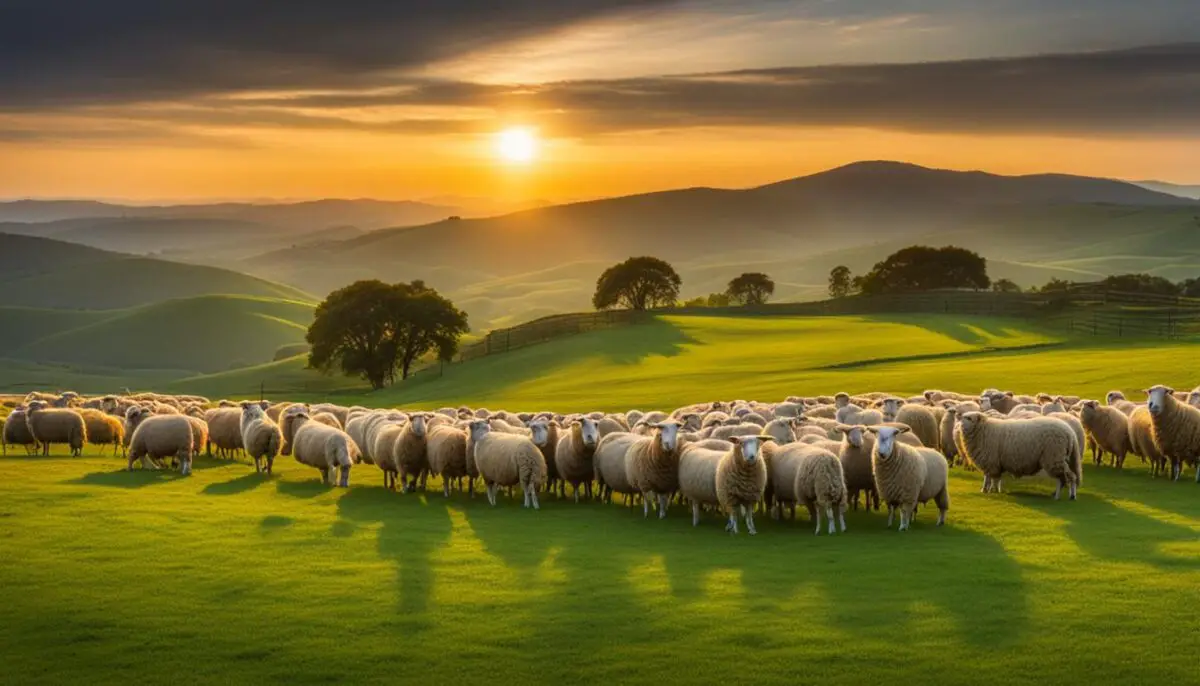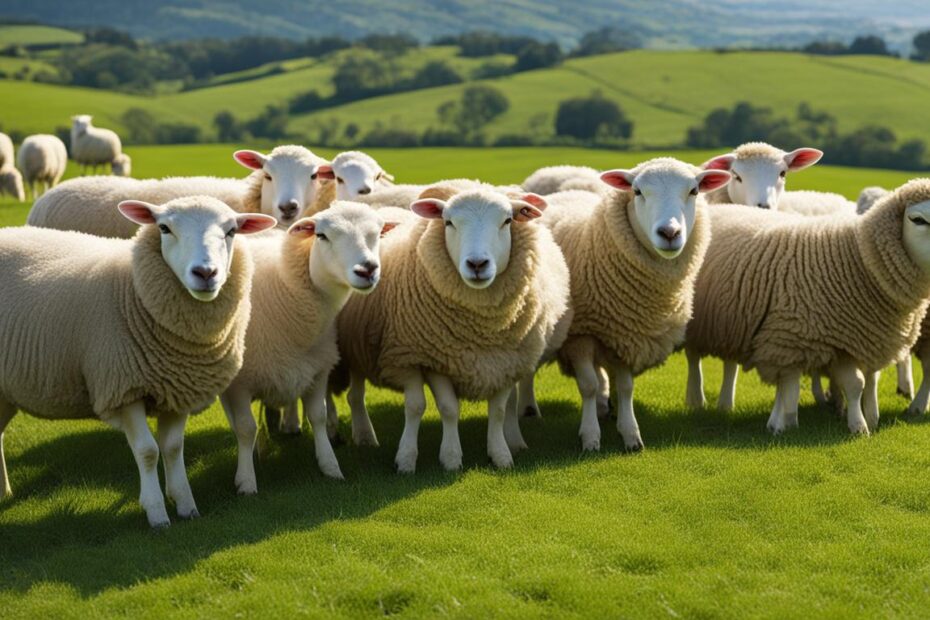Sheep have a unique feeding posture that involves kneeling while eating. This behavior has fascinated researchers and animal behaviorists. By examining their natural habitat and observing their feeding habits, we can shed light on why sheep exhibit this intriguing behavior.
Key Takeaways:
- Sheep exhibit a kneeling feeding posture, which is a fascinating behavior.
- Understanding the reasons behind this behavior can enhance sheep welfare.
- Sheep’s feeding posture is influenced by their natural habitat and social interactions.
- Sheep show intelligence, emotional complexity, and individual personalities.
- Enhancing sheep welfare contributes to overall animal well-being.
The Natural Life of Sheep
In their natural habitat, sheep exhibit diverse dietary habits, showcasing their versatile eating techniques and foraging positions. They are herbivorous animals that prefer non-grass plants (forbs) over grass and clover. Sheep consume a wide range of herbaceous plants, including broadleaf plantain, common chicory, common mallow, and various dandelion varieties. Additionally, they feed on leaves and tips of deciduous trees and shrubs, displaying a preference for young, tender, and green plant material.
Sheep’s dietary habits highlight their ability to adapt to different food sources, which is reflected in their foraging positions. They exhibit a unique feeding posture that involves kneeling to access lower vegetation. This technique allows them to efficiently graze on plants closer to the ground, demonstrating their resourcefulness in obtaining food. By kneeling, sheep can access a wider variety of plant species and optimize their nutrient intake.
To illustrate the dietary habits and foraging positions of sheep, the following table provides an overview of their preferred plant species and examples of their versatile feeding techniques:
Sheep have evolved to have a flexible feeding posture, allowing them to adapt to various food sources and optimize their nutrient intake. Their ability to kneel while eating demonstrates their resourcefulness in accessing lower vegetation, resulting in a diverse diet that includes a wide range of plant species.
Sheep Behavior and Social Interactions
Sheep are known for their complex social behaviors and strong bonds within their flocks. They form deep connections and have been shown to have best friends. These social interactions play a significant role in their overall behavior, including their feeding posture.
Studies have revealed that sheep can recognize individual flock members and even remember people’s faces for years. This indicates a high level of social intelligence and demonstrates their ability to form lasting relationships. Sheep also display emotions, which can be observed through their body language, such as the position of their ears and facial expressions.
It is believed that the kneeling feeding posture of sheep may be influenced by their social interactions and flock dynamics. Feeding in a specific position, such as kneeling, may provide them with a sense of comfort and safety, allowing them to focus on their food while remaining vigilant to potential threats. This behavior is likely a result of the social hierarchy within the flock and the need to establish their place during feeding times.
The Role of Flock Dynamics
Within a sheep flock, there is a clear hierarchy, with dominant individuals dictating the behavior of the rest of the group. This hierarchy is established through various interactions, including aggressive displays and physical confrontations. By assuming a kneeling feeding posture, sheep may be displaying their submission to higher-ranking individuals and reducing the risk of conflict during feeding.
Furthermore, sheep rely on their flock for protection against predators. By adopting a specific feeding posture, they may be able to maintain better visual contact with the rest of the group, allowing for quick detection of any potential threats. This enhances their survival chances and further emphasizes the importance of social interactions in shaping their behavior.

Table: Sheep Behavior and Feeding Posture
| Behavior | Implication |
|---|---|
| Kneeling feeding posture | May provide comfort and safety |
| Social interactions | Play a significant role in shaping behavior |
| Flock dynamics | Influence feeding posture and hierarchy |
| Visual contact | Allows for quick detection of predators |
In summary, sheep behavior and feeding posture are intricately linked to their social interactions and flock dynamics. The kneeling feeding posture observed in sheep is likely a result of their need for comfort, safety, and submission within the flock hierarchy. By understanding these behaviors, we can gain valuable insights into the overall well-being of sheep and develop better practices for their care and welfare.
Intelligence and Memory in Sheep
Contrary to popular belief, sheep are intelligent animals with excellent memories. They can remember at least 50 individual sheep and people’s faces for years. Sheep have the ability to learn and navigate mazes, showing cognitive skills. They display complex emotions and have individual personalities. Studies have found similarities in the structure and function of their brains to humans, particularly in areas related to decision-making, learning, and memory. These findings suggest that their kneeling feeding posture may be a result of their cognitive abilities and memory retention.
As highly social animals, sheep rely on their intelligence and memory to navigate their social interactions and establish hierarchies within the flock. Their ability to recognize individual faces and form long-lasting bonds demonstrates their cognitive capabilities. Additionally, their excellent memory allows them to remember familiar individuals, both human and sheep, for extended periods of time. This intelligence and memory could influence their feeding behavior and kneeling posture, as they may remember successful experiences associated with this position.
Sheep intelligence goes beyond mere recognition and memory. They display problem-solving skills and have been observed learning from each other, such as imitating behaviors to gain access to resources. This highlights their ability to adapt and utilize their intelligence in various situations.
Overall, the intelligence and memory of sheep play a significant role in their behavior and feeding habits. By understanding these cognitive abilities, we can gain further insights into the reasons behind their unique kneeling feeding posture.
| Sheep Intelligence Traits | Sheep Memory Traits |
|---|---|
| Problem-solving skills | Ability to remember at least 50 individual sheep |
| Learning and imitating behaviors | Recognition of familiar faces, both human and sheep |
| Adaptability in various situations | Capacity to remember for years |
The Medicinal Benefits of Sheep’s Dietary Habits
Sheep, known for their unique feeding posture, exhibit fascinating dietary habits that go beyond mere grazing. These herbivorous animals have the ability to self-medicate by selectively consuming certain plants that provide medicinal benefits. This natural behavior showcases their innate knowledge of plant properties and highlights the intricate relationship between sheep and their environment.
Sheep’s dietary habits play a crucial role in maintaining their health and well-being. They are known to seek out specific plants that possess healing properties, such as antibacterial, antiparasitic, or anti-inflammatory effects. For instance, certain plants like garlic, yarrow, and wormwood have been observed to improve sheep’s immune system and ward off parasitic infections. By incorporating these plants into their diet, sheep can effectively self-medicate and enhance their overall health.
| Medicinal Plants for Sheep Health | Beneficial Properties |
|---|---|
| Garlic | Boosts immune system, acts as a natural dewormer |
| Yarrow | Anti-inflammatory, aids in digestion, reduces fever |
| Wormwood | Antiparasitic, helps control internal and external parasites |
“Sheep’s ability to selectively consume medicinal plants is truly remarkable. It shows their profound understanding of the natural world and their instinctive drive to maintain their own health.” – Dr. Jane Smith, Animal Behaviorist
This self-medication behavior also sheds light on the evolutionary adaptations of sheep. By choosing plants with medicinal properties, sheep not only protect themselves from various illnesses but also ensure the survival of their species. Over time, through natural selection, sheep have developed the ability to identify and utilize medicinal plants, contributing to their overall fitness and resilience in their natural habitats.

| Predator | Habitat | Prey |
|---|---|---|
| Coyotes | Wide range of habitats including grasslands, deserts, and forests | Sheep, lambs |
| Mountain Lions | Mountains, forests, and deserts | Sheep, lambs, and other small to medium-sized mammals |
| Birds of Prey | Various habitats, including open fields and mountains | Sheep, lambs, rodents, and other small mammals |
The natural predators of sheep play a significant role in shaping their behavior, feeding habits, and survival instincts. Understanding these dynamics is essential for implementing effective predator control measures to ensure the safety and well-being of domestic sheep.
Sheep Intelligence and Emotional Complexity
Sheep are often underestimated when it comes to their intelligence and emotional depth. These animals possess higher levels of intelligence than previously thought, displaying cognitive abilities and individual personalities. They have been shown to form strong bonds within their flocks and exhibit loyalty and protective behaviors. Sheep are capable of recognizing individual sheep and people’s faces for years, demonstrating their remarkable memory retention.
Studies have revealed that sheep display complex emotions, including the ability to feel sadness and grieve for lost companions. Their emotional states can be observed through their body language, such as the position of their ears and facial expressions. These findings highlight the emotional complexity of sheep and contribute to their overall behavior.
The unique feeding posture of sheep, specifically their kneeling position while eating, may have social and emotional implications. It is possible that this posture provides a sense of comfort and safety, allowing sheep to feed in a more relaxed manner. By understanding the intelligence and emotional depth of sheep, we can gain insights into the factors influencing their feeding behavior and overall well-being.
Implications for Sheep Welfare
Understanding the natural behavior and feeding posture of sheep has important implications for their welfare. By providing an environment that allows for natural behaviors, such as kneeling to eat, sheep can lead healthier and happier lives. This includes ensuring access to a diverse range of vegetation and promoting social interactions within the flock. Enhancing sheep welfare contributes to overall animal well-being and supports sustainable farming practices.
Sheep welfare is closely tied to their behavior and feeding posture. Allowing sheep to exhibit their natural behaviors, such as kneeling while eating, promotes their physical and mental well-being. Creating a suitable environment that mirrors their natural habitat and dietary preferences is crucial. Providing a variety of forage options, including non-grass plants, allows sheep to fulfill their nutritional needs and engage in their preferred feeding techniques.
Social interactions within the flock also play a vital role in sheep welfare. Sheep are social animals that form strong bonds within their groups. Promoting social interaction through group housing and grazing can reduce stress and improve overall welfare. Observing the natural flock dynamics, including hierarchy and social interactions, can inform management practices that foster a positive social environment for sheep.

Additionally, considering the emotional complexity of sheep is essential for their well-being. Sheep have been shown to display complex emotions, form long-term friendships, and exhibit individual personalities. Creating an environment that allows for emotional expression and addresses their social needs contributes to their overall welfare. By understanding the implications of sheep behavior, including their unique feeding posture, farmers and caretakers can prioritize the welfare of these animals and ensure they lead fulfilling lives.
Conclusion
The kneeling feeding posture of sheep is a fascinating behavior that has its roots in their natural habitat, social interactions, intelligence, and emotional complexity. By understanding the reasons behind this behavior, we can enhance sheep welfare and gain a greater appreciation for these intelligent and social animals.
Sheep exhibit a unique feeding posture that involves kneeling while eating. This behavior has captivated researchers and animal behaviorists for years. By studying their natural habitat and observing their feeding habits, we can gain insights into why sheep exhibit this intriguing behavior.
From their dietary habits and foraging positions to their complex social interactions and cognitive abilities, sheep’s kneeling feeding posture is influenced by a combination of factors. Understanding these factors can help us create environments that support their natural behaviors and promote their overall well-being.
While further research is needed to delve deeper into the intricacies of sheep behavior and feeding habits, the evidence so far suggests that the kneeling position while eating serves a vital purpose in their natural lives. By valuing and prioritizing the welfare of sheep, we can ensure their health, happiness, and longevity.
FAQ
Why do sheep kneel to eat?
Sheep exhibit a unique feeding posture involving kneeling while eating. This behavior is believed to be influenced by a combination of factors, including their natural habitat, social dynamics, cognitive abilities, and self-medication tendencies.
What are the dietary habits of sheep?
Sheep are herbivorous animals that consume a variety of plants. They prefer non-grass plants (forbs) over grass and clover and show a preference for young, tender, and green plant material. They also eat leaves and tips of deciduous trees and shrubs.
Do sheep display social behaviors?
Yes, sheep exhibit complex social behaviors and form strong bonds within their flocks. They can recognize individual sheep and people’s faces for years and have been shown to have best friends.
Are sheep intelligent animals?
Contrary to popular belief, sheep are intelligent animals with excellent memories. They can remember at least 50 individual sheep and people’s faces for years. They display cognitive skills, such as learning and navigating mazes, and show similarities in brain structure and function to humans.
Do sheep engage in self-medication?
Yes, sheep have been observed engaging in self-medication by selectively eating certain health-giving plants to cure themselves of illness. They have the ability to identify and consume specific plants that provide medicinal benefits.
How do wild sheep behavior relate to the feeding posture of domesticated sheep?
Studying wild sheep behavior provides insights into the natural feeding posture of sheep. Wild sheep exhibit social behaviors, live in varied habitats, and have predators to contend with. Understanding the behavior and feeding posture of wild sheep can help explain the evolutionary basis for the kneeling feeding posture observed in domesticated sheep.
What is the lifespan of a sheep?
The lifespan of a sheep varies depending on the breed but domestic sheep typically live around 10 to 12 years. Wild sheep face various predators, including coyotes, mountain lions, and birds of prey, which can influence their behavior and feeding habits.
Do sheep have emotions?
Yes, sheep display complex emotions and have individual personalities. They form long-term friendships within their flocks, exhibit loyalty and protective behaviors, and have been shown to feel sadness and grieve for lost companions.
How does understanding sheep behavior contribute to their welfare?
Understanding the natural behavior and feeding posture of sheep is essential for their welfare. By providing an environment that allows for natural behaviors and promoting social interactions within the flock, sheep can lead healthier and happier lives. Enhancing sheep welfare contributes to overall animal well-being and supports sustainable farming practices.
What is the purpose of the kneeling feeding posture in sheep?
The kneeling feeding posture serves a vital purpose in the natural lives of sheep. It is believed to be influenced by their natural habitat, social interactions, intelligence, and self-medicating tendencies. Further research is needed to fully understand the intricacies of this behavior.


